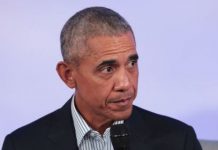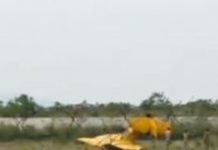Ajit Sahi visits a Taliban nerve centre that Pakistani Army has wrested control of, and finds that the peace may be hanging by a thread

Photo: AFP
SUDDENLY, IT’S dark and utterly suffocating. I’m only two metres into the cave, but it’s impossible to crouch and walk anymore in the bottleneck. And the Taliban lived here months and years? Unbelievable. I turn and shout, “Please move back!” Presently, I rush out to the open, stretch, take a deep breath and look around.
I am standing atop a hillock with miles of rippling landscape all around. It’s much chillier than in Islamabad, Pakistan’s capital to the east where I was two hours ago before a Pakistan Army helicopter brought me here flying over, among others, the legendary Kabul River. Some 20 km to the west are the mountains of Afghanistan, silhouetted by a haze of clouds. It rains here anytime.
Soldiers in khaki salwar-kameez, their fingers tense on their machine-gun triggers, guard the cave-bunkers. One young soldier has hoisted a launcher onto his shoulder; its rocket aims at an unseen enemy that the Army admits still isn’t all that far. Until last October, this exact spot was a nerve centre of the Pakistani wing of the Taliban, known as the Tehrik-e-Taliban Pakistan (TTP). Possibly scores of its cadres lived here when the Pakistan Army launched a full-scale attack, including aerial bombing. About 30 bodies were found after the three-day offensive.
“This was a stronghold of the miscreants,” says Major Jahanzeb, waving an arm at the clutch of the bunkers. “You can see how well-prepared they were.” This former defence enclave of the TTP first hit headlines in January 2006 when unmanned drone aircraft of the CIA fired four missiles on it in a bid to kill Osama bin Laden’s key lieutenant, Ayman Al- Zawahiri, who the US suspected hid here. He didn’t. Until the Army’s offensive in October, this was one of the Taliban’s most secure redoubts.
 These TTP bunkers are located in a village named Damadola that lies in Bajaur, a 1,300-sq km hilly tract in northwest Pakistan that was a Taliban stronghold for eight years. Bajaur is one of the seven pastoral “agencies” together known as the Federally Administered Tribal Areas (FATA). FATA is a thin north-south strip that is most of the vertical part of Pakistan’s 2,600-km border with Afghanistan.
These TTP bunkers are located in a village named Damadola that lies in Bajaur, a 1,300-sq km hilly tract in northwest Pakistan that was a Taliban stronghold for eight years. Bajaur is one of the seven pastoral “agencies” together known as the Federally Administered Tribal Areas (FATA). FATA is a thin north-south strip that is most of the vertical part of Pakistan’s 2,600-km border with Afghanistan.
Located at FATA’s top, Bajaur is its smallest but most populated agency, with more than 1.2 million of FATA’s over three million people. Nearly all the residents of FATA are Pashtuns, who identify themselves socially, politically and culturally only by the tribes to which they belong. By tradition and Constitution, FATA has far greater administrative autonomy than other Pakistani provinces such as Punjab and Sind. FATA runs on centuries- old laws, such as the one that awards collective punishment to a tribe’s people for an individual’s crime.
“Except for Khar, the capital of Bajaur Agency, the TTP dominated the rest of it — the roads, the posts, the valley,” says Pakistan military spokesman, Major General Athar Abbas. After a false start, in which the army lost significant ground wrested from the Taliban, the area was reclaimed in a fresh offensive and is now said to be under control. “We hammered them,” says Colonel Muhammad Nauman Saeed, Commandant of the Bajaur Scouts, which ran the operations.
 Few doubt the Army effort to chase the Taliban out. But many claim the Pakistan Army has only achieved a partial success, since the TTP leadership is still at large. “The Army failed to capture Taliban leaders like Maulvi Faqir Ahmed and Qari Zia-ur-Rehman,” says human rights activist Idris Khattak, who lives in Naushera town 150 km to the east and reports for Amnesty International from the region. “The people fear that the Taliban may yet come back to the area.” Maulvi Faqir is believed to have fled from Damadola following the Army attacks.
Few doubt the Army effort to chase the Taliban out. But many claim the Pakistan Army has only achieved a partial success, since the TTP leadership is still at large. “The Army failed to capture Taliban leaders like Maulvi Faqir Ahmed and Qari Zia-ur-Rehman,” says human rights activist Idris Khattak, who lives in Naushera town 150 km to the east and reports for Amnesty International from the region. “The people fear that the Taliban may yet come back to the area.” Maulvi Faqir is believed to have fled from Damadola following the Army attacks.
Reportedly, the Taliban are still active in many places in Bajaur. According to Hisbanullah, a journalist in Bajaur who works with Pakistan’s Geo television news channel, the Taliban kidnapped five men in Bajaur last week. Of them, they beheaded a well-known Islamic scholar, Maulana Hakimullah. A note left with his body warned of a similar fate for those who informed against the Taliban.
Hisbanullah says Pakistan Army controls only 80 percent of Bajaur while the Taliban control the rest. “There is a great possibility that the Taliban might take control of many areas now controlled by the army, as none of the main Taliban leaders from Bajaur have been killed or arrested till now,” says Hasbinullah.
The Taliban continue to be active across FATA. On April 23, in North Waziristan, the second southernmost FATA agency, the Taliban ambushed a Pakistan military convoy, killing seven soldiers. Audacious Taliban gunmen using rocket launchers surrounded the Army convoy and opened fire. Elsewhere in FATA, the Taliban beheaded five people they accused of spying for the US and Pakistan. Handwritten notes were found with the bullet-riddled headless bodies.
Indeed, it is surprising that the Pakistan Army has not gone after the Taliban leadership holed up in North Waziristan. The US believes that at least two warlords — pro-Taliban militant commander Jalaluddin Haqqani and TTP Commander Hafiz Gul Bahadur — are using their bases in North Waziristan to mount attacks on the US-led military in Afghanistan across the border. This has triggered doubts over the Pakistan Army’s sincerity in flushing out the Taliban. Colonel Nauman, however, says that his army is stretched thin and the operations in North Waziristan cannot yet be mounted on a massive scale.
Pashtuns sympathised with the Taliban, seeing them as victims of the US invasion
The continuing Taliban activity should certainly be cause for sleepless nights in the Pakistan Army, if it is serious about wiping out the Taliban as it vociferously claims (see interview with Major General Athar Abbas on p17) — as well as the US, which would be loath to see the Taliban resurge once Western troops leave Afghanistan in 2011 as President Barack Obama has planned.
According to activist Khattak, the highly tenuous peace continues to hold in Bajaur only because the local people have asked the Army to stay on, fearing the Taliban’s return. Indeed, US and Pakistani action against the Taliban will succeed only if FATA stays rid of the terrorists who have long held sway there.

Photo: AFP
It could be long before the Taliban are fully flushed out of FATA. It is well known that the US and Pakistan had used the FATA region to create, fund, arm and train Islamic fighters to taken on former Soviet Union’s military when it occupied Afghanistan from 1979 to 1989. “Pakistan became a frontline state against the expansionist design of the Soviet Union,” says Colonel Nauman. “To be able to launch an operation against the Soviets, FATA was the most suitable springboard.”
BECAUSE THE Pashtun tribes of the region were hardly Islamists, the US pumped in hundreds of millions of dollars there and, working with the Pakistan Army, brought in Arab and Central Asian Muslim fighters to the theatre to bludgeon the locals’ objections to the hardcore Islamist agenda of the Taliban. After the Soviets withdrew, Afghanistan emerged as a state of warlords with money who appropriated much of the equipment the retreating Soviet Army left behind.
For several years, Afghanistan saw a bloody civil war between the Taliban and Northern Alliance of the non-Pashtun tribes. The porous border between Pakistan and Afghanistan — there are four big passes and umpteen minor passes into Afghanistan from Bajaur alone — gave the Taliban strategic depth in Pakistan to fight their war in Afghanistan. In 1996, the Taliban captured Kabul.
Colonel Nauman, who speaks fluent Pashto and has led the Bajaur Scouts for two years, reflects the dominant thinking in the Pakistan Army when he says that the failure of the US to continue its engagement with the anti-Soviet mujahideen proved to be a fatal mistake. It is now a fact of history that the Taliban government in Afghanistan gave Al Qaeda sanctuary, from where Osama bin Laden orchestrated the September 11, 2001 terror attacks on the United States. This proved to be a watershed. The US attacked Afghanistan in December 2001, and to escape the bombings, the Taliban fled into Pakistan, especially into FATA.
The army claims the Taliban lost support once it turned locals into human shields
According to Pakistan Army officers who have engaged with the local Pashtuns over several years, the retreating Taliban found easy acceptance in FATA because the locals had known them for two decades since the anti-Soviet war. Besides, the two were ethnically the same. The Taliban had sympathy among the Pashtuns in FATA because they saw them as victims of the US invasion. What assured the Taliban of hospitality in FATA was the tribal custom that mandated the host to protect anyone who seeks a sanctuary.
Over the next four years, while continuing to regroup inside Pakistan, the Taliban also began to infiltrate the Islamic seminaries in FATA, the madrassas. “They started teaching a perverted version of Islam,” says Colonel Nauman. “They began recruiting children.” By 2006, the Taliban began to run the local administration in several areas, man checkpoints and collect revenue.
They also roamed freely displaying arms. Alarm bells rang when the Taliban began to move east of FATA, into the “settled areas” of the Northwestern Frontier Province (NWFP), the Pakistani province that adjoins FATA. (NWFP was last month renamed by a Constitutional amendment as Khyber Pakhtunwa.)
“In short,” says Colonel Nauman using a phrase popular with Indian security agencies, too, “the writ of the government was non-existent in FATA as the Taliban had begun to rule.” Two years ago, the Army found a letter of “approval” signed by an Afghan Taliban commander allowing an industrialist to open a cement factory in FATA. “That made us sit up,” says Nauman. By now, the Taliban had also taken over the local courts, and were administering justice in Bajaur.
Simultaneously, the Pakistan government was also under tremendous pressure from the US to up the ante against the Taliban. Terror attacks inside Pakistan had increased as well, most notably by ultras inside the Red Mosque in July 2007 and on the Marriot Hotel in September 2008, both in Islamabad. In the same month of the attack on the Marriot, Pakistan Army launched Operation Sherdil, a massive offensive including aerial attacks, and reached Bajaur’s capital, Khar, in four days. Although Damadola is only about 5 km from Khar, it would be another 13 months before the Army would be able to clear out the TTP nerve centre there.
The Pakistan Army claims that the peace currently prevailing in Bajaur will hold because a key tribe, which lives in areas bordering Afghanistan and which supported the Taliban until recently, has signed an agreement with it abjuring its support for the Taliban. This was the famous 28-point “surrender” to the Pakistan Army in return for amnesty and protection, signed by 700 tribe elders.
But here, too, the Taliban returned and Pakistan Army had to restart the offensive. It was a big relief for Army generals that tribesmen stuck to their promise made in the surrender document and refused to back the Taliban. Indeed, sealed as it was as per age-old tribal custom, this agreement gave hope to the Pakistan Army that in future, too, they should prefer signing the tribes on according to ways familiar to them.
The Pakistan Army also claims the Taliban have lost support of the local people in FATA on their own, after they started using innocent people as “human shields” as also converted people’s homes into their hideouts. It must be said that the Pakistan Army did not provide us access to the local populations for conversations to verify these claims about the Taliban.
However, activists such as Khattak, who are by no means apologists for the Pakistan Army, do confirm that the Taliban terrorised the people of FATA and in the settled areas, forcing them to provide them with logistic and financial support or face slaughter. In fact, Khattak believes that the Pakistan Army isn’t doing enough to finish off the Taliban. About six months ago, Khattak recalls, the Taliban kidnapped his neighbour, a farmer, returning him only months later after his family sold off his farm to pay ransom for his release.
THE ARMY has faced tough battles even in the Swat Valley, which is to the northeast of Bajaur, just outside FATA in NWFP. In November 2007, it launched an operation against the Taliban there and claimed to have secured it in six weeks. However, a local government installed there following elections chose to negotiate with the Taliban, and the Army was returned to the barracks. Predictably, the Taliban moved in again, began killing all those who had sided with the Army, and took control of the valley.
“They executed them brutally,” says Major General Athar Abbas. This caused a complete lack of support for the army in the Swat Valley. When it re-launched its military offensive, the Army “faced great difficulties” and had to “over-rely” on force, which resulted in “great destruction, death and displacement”. To be sure, 2.2 million people had been displaced by the middle of last year. Abbas claims that most people have since returned to Swat, but admits the army needs to keep control to ensure that the Taliban do not return.
In fact, the Pakistan Army faces three key challenges in its biggest face-off with the Taliban. One, it continues to put its men at risk across FATA and northwestern NWFP, where it has lost more than 800 soldiers to the Taliban fire since the operations began in Swat in November 2007. (Over 2,600 soldiers have been injured.) Two, it would be impossible for the Army to clear out every area infiltrated by the Taliban across the Afghanistan-Pakistan border. Major General Abbas admits that this cannot happen and says the Army can only clear the area for the government to move in and do its job.
Three, the biggest challenge, is the huge deficit of trust the Pakistan Army faces not just with the US, but with the people of Pakistan as well. For nearly two decades, the Pakistan Army and its Directorate of Inter-Services Intelligence (ISI) mentored the Taliban. Indeed, the Taliban were born during the rule of General Zia ul-Haq, Pakistan’s most dreaded dictator who ruled from 1977 until his death in an air crash in 1988. General Zia backed the Taliban, a policy that successive Pakistan rulers, including General Pervez Musharraf, followed.
When Musharraf did a U-turn after the 2001 attacks in the US, the Taliban and its allied militant groups began turning against the Pakistani establishment, bringing on terror attacks aiming to hit Musharraf himself, the ISI offices, Army buildings — including its headquarters — and at public places across Pakistan. Yet, incredibly, it is still believed by many in Pakistan that the Army seeks to keep the Taliban alive in the hope that they will recapture Afghanistan once US-led military forces quit that country after July 2011.
Indeed, it is true that Islamabad cannot afford to end up a loser in Kabul after Western troops withdraw, especially since India is making every effort to win a stake in Afghanistan. “The art of being wise,” runs the adage painted on a board at the headquarters of Bajaur Scouts, “Is the art of knowing what to overlook.” Stretched while it is in its fight against the Taliban, the Pakistan Army can hardly overlook its nation’s need to ensure a hand in Afghanistan in the years to come.
[box]
“Our Operation Has Broken The Taliban Myth”
Major-General Athar Abbas, DG, Inter-Services Public Relations of the Pakistan military, spoke to Ajit Sahi in Rawalpindi. Excerpts:
 Why is there no military operation against the Taliban in North Waziristan?
Why is there no military operation against the Taliban in North Waziristan?
The operation in South Waziristan was of a huge magnitude as the state had completely lost that space to the Tehreek-e-Taliban Pakistan (TTP). It had become a sanctuary for all terrorist groups, whether based in FATA or Punjab. The Masood tribesmen are fierce fighters. Abdullah Mehsud had wiped out the paramilitary and destroyed the posts. Starting October 16 last, the army conducted ground operations from three directions and in six weeks time the main centres were cleared. Even now, stabilisation operations are on. Until the countryside is consolidated, any big operation will risk the control procured in the area.
Could the Taliban return?
The military with the police, the administration and other paramilitary forces is manning Swat and other areas. You cannot rule out individual incidents of terrorism. But there is only a remote possibility of their [Taliban’s] carrying out a big attack. Of course, there is no ideal situation. It takes much longer for insurgencies like this to completely go off. But the markets are open, people are back to work, and the administration that had bolted has started functioning.
What were the challenges in Swat?
We cleared the Swat valley in six weeks from November 2007. Many militants were killed and many escaped to nearby valleys. Elections were held and the new government negotiated with the Taliban. The army was asked to retreat, because of which the terrorist re-captured the valley and many more were killed. As a result the military faced a lack of public co-operation in its second operation. Therefore, the Swat Taliban were given a new offer. But we realised the terrorists wanted more power, area, and authority. They started moving out of Swat into other areas and continued their brutality. That was the time when public opinion changed. There was a national mood to start an operation against the Taliban. Beginning May last, we attained success in five-to-six months. The army had to land on peaks as the roads were completely blocked. We had to go through narrow gorges in Taliban areas. More than 2.2 million people were displaced. We cleared areas no one had entered before. There were huge Taliban hideouts and sanctuaries in Swat.
Why do you object to US drone attacks?
The drone harms more than it helps. We won’t like to lose public support, which is crucial to any counterinsurgency. Public opinion has been divided in the country. It is fragile and therefore one is very careful when conducting operations. The media in our country is, like yours, aggressive but currently supports the operation. It has anti-American segments and strong anti-war lobbies also. Of course, this is our war not a US war. This issue is important in these operations.
Shouldn’t governments take over?
Our comprehensive strategy is to clear, hold, build and transfer. The third and the fourth is a civilian component. The effect of the military operation is that the myth [of the Taliban] is broken, they are dislodged from their main bases, and their training camps and logistics disrupted. The writ [of the State] is to a great extent established. The mid-tier leadership including a few top leaders [of the Taliban] has been eliminated. The locals’ confidence is restored. The civil administration has capacity problems. It hasn’t stopped terrorist acts in cities and towns but [these acts have] gone down to great extent.
What are the serious outstanding issues?
The madrassa problem needs attention. The rehabilitation of the displaced is a serious issue, which can lose us in the refugee camps what we won in the operations. There is a capacity problem of the administration and it requires attention. The militant is also very proactive and therefore requires management. We have a problem with hate literature in our country. It is proliferating and we need to look into it.
[/box]
ajit@tehelka.com













